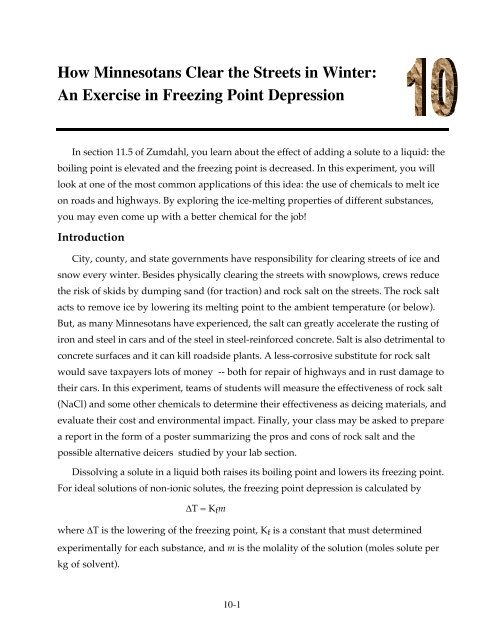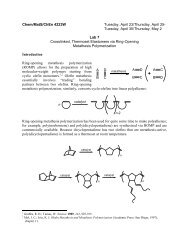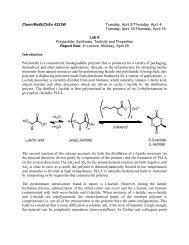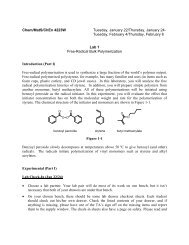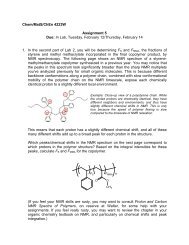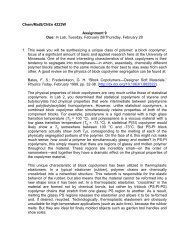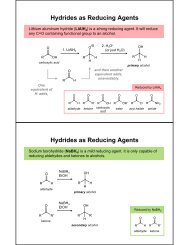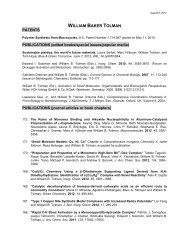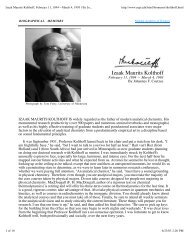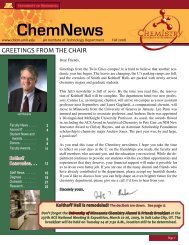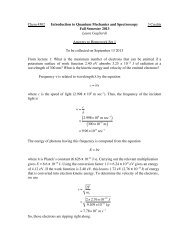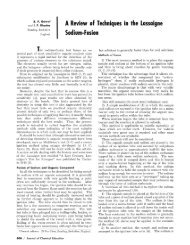An Exercise in Freezing Point Depression
An Exercise in Freezing Point Depression
An Exercise in Freezing Point Depression
- No tags were found...
Create successful ePaper yourself
Turn your PDF publications into a flip-book with our unique Google optimized e-Paper software.
Week One: Gather<strong>in</strong>g DataYour TA will divide your lab section <strong>in</strong>to five groups of 3 to 5 students per group.He or she will then assign one of the follow<strong>in</strong>g 5 deicers to each group: NaCl, KCl,KC 2H 3O 2, MgCl 2, or CaCl 2. If your group consists of 4 or 5 students, it will be most timeefficient to split up and use two computers. You’ll need to calibrate a temperature sensor(Part IA) for each computer. One group should beg<strong>in</strong> by prepar<strong>in</strong>g the two beakers forPart IIA, then calibrat<strong>in</strong>g the temperature sensor and f<strong>in</strong>ally proceed<strong>in</strong>g with Part III.The second group will also do Part I A and will then proceed with trial 1 of Part IB.All of Part IB needs to be done us<strong>in</strong>g the same computer, but each group member shouldbe part of at least two freez<strong>in</strong>g po<strong>in</strong>t depression trials—first as an “assistant/learner” andthen as the “leader/tra<strong>in</strong>er”. All group members will need to keep a record of all datacollected on Data Sheet I. If you calculate and plot ∆T vs. m as you go, and if you obta<strong>in</strong> agood straight l<strong>in</strong>e for trials 1 through 4, you may omit trial 5 and proceed to trial zero.Omitt<strong>in</strong>g trial 5 will significantly reduce the amount of chemical used.Week Two: Compar<strong>in</strong>g Data on Deicers and Evaluat<strong>in</strong>g their Effectiveness1. Compare the damage to nails <strong>in</strong> each deicer after one week.2. If not completed dur<strong>in</strong>g week one, compare concrete samples.3. Each group <strong>in</strong> your lab section will share its experimental results and observationsfor Parts I, II and III. See Post-Lab Questions 2 through 4 for further directions.EXPERIMENTAL SECTIONWaste TreatmentBecause road deic<strong>in</strong>g chemicals would be applied by the ton, we have chosenenvironmentally safe substances to study. Unless announced to the contrary by your TA,all solutions and dry solids may be r<strong>in</strong>sed down the dra<strong>in</strong> with runn<strong>in</strong>g water.Part I Freez<strong>in</strong>g Po<strong>in</strong>t <strong>Depression</strong>A. Calibration of Temperature ProbeYou will be calibrat<strong>in</strong>g the temperature probe for your <strong>in</strong>strument us<strong>in</strong>g two knowntemperatures – that of boil<strong>in</strong>g H 2O and that of freez<strong>in</strong>g H 2O. You will need to obta<strong>in</strong> oneor more temperature probes for your group.10-4
B. The Corrosive Effects of Deicers on Concrete and Iron Surfaces Dur<strong>in</strong>g RepeatedFreeze - Thaw CyclesConcrete scal<strong>in</strong>g refers to damage done to concrete surfaces under various conditions. Theamount of scal<strong>in</strong>g is rated from 1 to 5, with 1 be<strong>in</strong>g no surface damage dur<strong>in</strong>g the studyand 5 be<strong>in</strong>g the most significant damage.Two sets of concrete samples were prepared <strong>in</strong> plastic conta<strong>in</strong>ers. One set consists ofconcrete <strong>in</strong> 1300 mL beakers. In the second set, the concrete samples were placed <strong>in</strong> 800mL conta<strong>in</strong>ers and a U – shaped iron bar was imbedded <strong>in</strong> the concrete. Each concretesample was covered with one of 9 different solutions and was then subjected to 10 freezethawcycles between about -17°C and room temperature. Because of the time required toprepare the concrete samples and to put them through a number of freeze – thaw cycles,the samples were prepared and treated outside of the regular laboratory and over aperiod of several weeks. The result<strong>in</strong>g concrete samples will be on display dur<strong>in</strong>g the twoweeks spent on Experiment 10.1. Exam<strong>in</strong>e the concrete samples which have no iron bars present, estimate theamount of scal<strong>in</strong>g on each sample and report the results, which will be subjective,on Data Sheet IIB.Do not touch the concrete surfaces!2. Also describe the extent of corrosion on the U – shaped bars on a scale of 1 to 5 andreport the results on Data Sheet IIB. Once aga<strong>in</strong> the results, while reported to thebest of your ability, are qualitative. For a given deicer, did the presence of the ironbar affect the amount of scal<strong>in</strong>g on the concrete surface?3. Look around campus and around town for places where rusty iron bars and flakedconcrete reveal damage to bridges, park<strong>in</strong>g ramps, roadways, etc. (H<strong>in</strong>t: A photoof serious rust or crumbl<strong>in</strong>g concrete, with the location noted, would be a goodaddition to your lab report or to a poster on deicers.10-8
Part III: Determ<strong>in</strong><strong>in</strong>g the Enthalpy of Solution, ∆H solnMany factors go <strong>in</strong>to mak<strong>in</strong>g a deicer both effective and practical. <strong>An</strong> obvious one,perhaps so obvious we usually don’t mention it, is solubility. S<strong>in</strong>ce freez<strong>in</strong>g po<strong>in</strong>tdepression is proportional to the molality of the dissolved solute, a solute with lowsolubility <strong>in</strong> water would be useless as a deicer. Therefore, you wouldn’t expect to seeCaCO 3used as a deicer because of its low solubility although it has other problems aswell.<strong>An</strong>other factor to consider <strong>in</strong> select<strong>in</strong>g a deicer is its enthalpy of solution. If a soliddissolves exothermically, it will provide heat to its surround<strong>in</strong>gs and tend to <strong>in</strong>crease theamount of ice melted per gram. From Section 11.2 of your text (Zumdahl, 5 th Ed.), we seethat the dissolv<strong>in</strong>g process can be considered to take place <strong>in</strong> three steps. Accord<strong>in</strong>g toHess’ Law, the overall enthalpy of solution is the sum of the enthalpies of the three<strong>in</strong>dividual steps. The first two steps require the separat<strong>in</strong>g of solvent particles and soluteparticles (or “expand<strong>in</strong>g” the solvent and solute) and are always endothermic. The thirdstep is the com<strong>in</strong>g together of the solute and solvent particles. If this step is sufficientlyexothermic, the overall process is exothermic. (Consider the rule learned earlier that “likedissolves like”. The stronger the attraction between solvent and solute particles, the moreexothermic, or less endothermic, we would expect the third step to be.)For an ionic solid such as NH 4Cl, the overall reaction for dissolution isNH 4Cl(s) + H 2O(l) → NH 4 + (aq) + Cl - (aq)∆H soln? If a salt dissolves endothermically, will the temperature of the result<strong>in</strong>g solution <strong>in</strong>crease ordecrease? Will the ∆H solnyou calculate be a positive or a negative number?In this part of the experiment you will determ<strong>in</strong>e the approximate enthalpy of solution foryour deicer. Dur<strong>in</strong>g week two, you will also collect ∆H solnvalues for the other deicers anduse these values to help rank the deicers from the salt which dissolves with the largestnegative enthalpy of solution to the one which dissolves with the largest positive enthalpyof solution.10-9
Part A. Determ<strong>in</strong>ation of the Calorimeter ConstantRefer to Experiment 5 for a sample calculation of a calorimeter constant. Yourcalorimeter is not perfectly <strong>in</strong>sulat<strong>in</strong>g; that is, a small amount of heat is either absorbed orreleased by the calorimeter each time you run an experiment. The amount of heat ga<strong>in</strong>edor lost by the calorimeter per degree change <strong>in</strong> temperature is called the calorimeterconstant. It is the heat capacity of your calorimeter. You will determ<strong>in</strong>e this constant bymix<strong>in</strong>g warm water with cool water <strong>in</strong> your calorimeter.1. Us<strong>in</strong>g your small graduated cyl<strong>in</strong>der, measure approximately 5 mL of cool water(approximately 10°C – you may use the water from your ice bath used <strong>in</strong> thecalibration of your temperature sensor) and record its volume to the nearest 0.02mL. Pour the water <strong>in</strong>to a calorimeter well. Us<strong>in</strong>g a clamp place the temperatureprobe <strong>in</strong>to the well such that it is read<strong>in</strong>g the temperature of the water but is nottouch<strong>in</strong>g the sides or bottom of the well.2. Go to the “set up run” menu and adjust the run to 5 m<strong>in</strong>utes with a sampl<strong>in</strong>g rate of60 samples per m<strong>in</strong>ute. Beg<strong>in</strong> the run and then quickly, us<strong>in</strong>g the same smallgraduated cyl<strong>in</strong>der as before, measure approximately 5 mL of hot water (about 30 -35°C) from the hot-water tap and record its volume to the nearest 0.02 mL.Immediately before mix<strong>in</strong>g the two solutions read and record the <strong>in</strong>itial temperatureof the hot water us<strong>in</strong>g the digital thermometer.3. Pour the hot water <strong>in</strong>to the well and stir until the temperature stops ris<strong>in</strong>g. Click onthe stop run button. To obta<strong>in</strong> the <strong>in</strong>itial temperature of the cold water, use themouse to highlight the portion of the graph immediately prior to the addition of thewarm water and then click on the “stat” button (a box will appear that will give youthe average temperature of the water for the portion of the graph you highlighted).Repeat this procedure to obta<strong>in</strong> the maximum temperature reached. This is the f<strong>in</strong>altemperature of the solution. Record these <strong>in</strong>itial and f<strong>in</strong>al temperatures <strong>in</strong> yournotebook. For all temperature measurements, do not rest the probe on the bottomof the flask!10-10
Part B. Determ<strong>in</strong>ation of ∆H solnfor your Deicer1. Refer to Table 10.1 to confirm that the suggested mass of sample will dissolvecompletely <strong>in</strong> 10 mL of water.2. Use a small graduated cyl<strong>in</strong>der to measure 10 mL of water <strong>in</strong>to a calorimeter well.Record the exact volume (to the nearest 0.02 ml) on Data Sheet III. Suspend acalibrated temperature sensor <strong>in</strong> the water.Suggested Sample Sizes:CaCl 2 0.6 to 1.0 g KCl 1.5 to 2.0 g MgCl 2 0.25 to 0.3 gNaCl 1.25 to 1.75 g KC 2 H 3 O 2 1.5 to 2.0 g3. Weigh the <strong>in</strong>dicated amount of salt <strong>in</strong> a small, clean, dry beaker and record its mass.Beg<strong>in</strong> the run and when the temperature sensor read<strong>in</strong>g has reached a constanttemperature add the salt to the well. Stir with the temperature sensor until thetemperature reaches a maximum or a m<strong>in</strong>imum. Record the <strong>in</strong>itial temperature ofthe water as well as the maximum or m<strong>in</strong>imum temperature reached. You can nowpredict the sign of ∆H soln4. R<strong>in</strong>se the well thoroughly with DI water and repeat the procedure, adjust<strong>in</strong>g themass of sample used, sampl<strong>in</strong>g rate, etc. if necessary.5. Referr<strong>in</strong>g to the sample calculation below, calculate the enthalpy (heat) of solution foryour deicer <strong>in</strong> J/g and kJ/mol. If the specific heat of your deicer is not given <strong>in</strong> Table 10-1,use the specific heat of water, 4.184 J/g°C, for your solution of dissolved deicer.Table 10.1Solubility (g/100mL H 2O) and Specific Heat (J/g°C) of an Aqueous Solution ofSelected Ionic CompoundsCompound Solubility(°C)Solubility(100°C)Specific Heat (J/g°C)of Salt SolutionNH 4 Cl 29.7 (0°C) 75.8 3.31CaCl 2 74.5 (20°C) 159 3.75KCl 34.7 (20°C) 56.7 3.45MgCl 2 54.2 (20°C) 72.7 3.94NaC 2 H 3 O 2 119 (0°C) 170 3.32NaC 2 H 3 O 2 •3H 2 O 76.2 (0°C) 138 (50°C) 3.32KC 2 H 3 O 2 253 (20°C) 492 (62°C) -----------NaCl 35.7 (0°C) 39.1 3.6010-11
Sample Calculation: Determ<strong>in</strong>e the Enthalpy of Solution of Ammonium Chloride.A student is asked to add ~2g of NH 4Cl to 10mL of water and to use the change <strong>in</strong>temperature to calculate ∆H soln. The reaction below corresponds to the enthalpy ofsolution of ammonium chloride.NH 4 Cl(s) + H 2 O(l) → NH 4 + (aq) + Cl - (aq)∆H solnA student first checked the solubility of NH 4Cl to make sure that a 2 g sample woulddissolve <strong>in</strong> 10 mL of water. She reasoned that because 2.97 g will dissolve <strong>in</strong> 10 mL ofwater at 0°C and s<strong>in</strong>ce the solubility of NH 4Cl <strong>in</strong>creases with temperature, a 2 g sampleshould readily dissolve at room temperature. She then stirred 2.105 g of NH 4Cl <strong>in</strong>to 10.00mL of DI water and observed that the temperature changed from 24.2°C to 11.1°C. Thecalorimetry constant for the well used was 5.8 J/°C. If q solnis the heat transfer associatedwith the dissolv<strong>in</strong>g of the salt sample and q is the heat lost or ga<strong>in</strong>ed by the solution ofwater and salt, thenq soln + q + q cal = 0q soln + (mass of salt + mass of water)(C sp solution)(∆T) + (5.8 J/°C)(∆T) = 0q soln + (2.105g NH 4 Cl + 10.0 mLx 0.997g/mL)(3.31 J/g°C)(11.1°C – 24.2°C) +(5.8 J/°C)(11.1°C – 24.2°C) = 0q soln − 524 J − 76 J = 0 and q soln ≅ 6.00 x 10 2 J∆H(J/g) = (6.00 X10 2 J)÷(2.105 g) = 285 J/g∆H (kJ/mol) = (285 J/g) (1 kJ/ 1000 J) (53.49g/mol) = 15.2 kJ/mol10-12
Name: _________________________________________ Date:___________________Pre-Lab Questions for Experiment 10Four students have completed Part I of Experiment 10. Their deicer was NH 4Cl (molarmass = 53.49 g/mol). The data for trials 1,2, and 3 is given <strong>in</strong> the follow<strong>in</strong>g table.For trial 0, the freez<strong>in</strong>g po<strong>in</strong>t of water, the temperature was 0°C and m = 0. Refer to thisdata to answer the questions below.1. Complete the Table below. Show your work for parts c, d, e, and f.Trial 1 Trial 2 Trial 3Mass of deicer used 1.920 g 4.119g 5.861gMass of water added 50.525g 49.872g 48.955gMass of ice melted 10.584g 23.916g 32.074gM<strong>in</strong>imum temperature reached -2.11° -3.88°C -4.70°Ca) Mass of water <strong>in</strong> f<strong>in</strong>al solutionb) kg of water <strong>in</strong> f<strong>in</strong>al solutionc) Moles of deicer usedd) ∆Te) Molality of f<strong>in</strong>al solution*f) Grams of ice melted/ g deicer* The value required here is "m" not "i x m"c)d)e)f)10-13
2. Prepare a plot of ∆T vs. m. Include trials 0 through 3. Use Excel or the graph paperat the back of the Manual. Each part (a, b, and c below) must be entirely correct toreceive credit for that part.a) Put your name on the graph, provide a title, and label the axes.b) Plot the 4 data po<strong>in</strong>ts and draw the “best” straight l<strong>in</strong>e.c) Calculate the slope of your l<strong>in</strong>e, ∆T = imK fd) Calculate “i” from this slope. (Slope = iK f)e) What is the theoretical value of "i" for NH 4Cl? How does your value compareto the theoretical value of “i” for NH 4Cl?f) Use the experimental value of “i” to determ<strong>in</strong>e the “colligative molality, i x m,where m is the calculated molality of the compound (not of the ions.)10-14
Name: _________________________________________ Date:___________________Partner(s): _________________________________________ TA: ____________________Data Sheet I: Data and Calculations for Part ICalibration Data: Slope: ______________ Intercept: ______________Deicer: ______________ Molar Mass of Deicer: ___________For each trial, record the experimental data.Trial 0 1 2 3 4 51. Mass of cup ~2 g2. Mass of deicer 03. Mass of cold H 2 O ~ 50 g4. M<strong>in</strong>imum temperature5. Total mass after add<strong>in</strong>g ice ~65 g6. Mass of cup + rema<strong>in</strong><strong>in</strong>g ice xxxFor each trial you carried out, complete the table below:Trial 0 1 2 3 4 57. Mass of deicer (2) xxx8. Mass of cup, cold water, xxxand deicer (1+2+3)9. Mass of ice added (5-8) xxx10. Mass of ice rema<strong>in</strong><strong>in</strong>g xxx(6-1)11. Mass of ice melted xxx(9-10)12. Mass of f<strong>in</strong>al solution xxx(5-6)13. Mass of water <strong>in</strong> f<strong>in</strong>al xxxsolution (12-2)Complete the table below (see Post-Lab Question 1.) Show complete calculations for 2 trialson the next page.Trial 0 1 2 3 4 5Moles of deicer usedKilogram of water <strong>in</strong> the f<strong>in</strong>alsolutionMolality of f<strong>in</strong>al solution∆T = |0°C - T f |Grams of ice melted per gramof deicerxxxxxxxxxxxxxxx10-15
Show the calculations required for any two of Trials 1 through 4.Trial Number: _______Trial Number: _______10-16
Name: _________________________________________ Date:___________________Partner(s): _________________________________________ TA: ____________________Data Sheet IIA:Observation of the Corrosive Effects of Deicers onIron NailsWrite a brief description of the nail surfacesTime Exposed Pla<strong>in</strong> H 2 O H 2 O + DeicerAfter 30 m<strong>in</strong>utesAfter 1 hourEnd of Lab (total time nailsexposed = _______)After 1 weekCorrosion Results After One Week for the Rema<strong>in</strong><strong>in</strong>g DeicersSee Data Sheet IIB for directions for "rat<strong>in</strong>g" the samples.Deicer Sample Observation Rat<strong>in</strong>g10-17
Data Sheet IIB:The Corrosive Effects of Deicers on Concrete and theSurfaces of Iron Embedded <strong>in</strong> ConcreteCAUTION: Do not physically disturb the surface of the iron rod or the surface of theconcrete dur<strong>in</strong>g your exam<strong>in</strong>ation of the samples.ConcreteRat<strong>in</strong>gConcrete Sample Rat<strong>in</strong>g1 2 3 4 5Some Scal<strong>in</strong>gsurface penetrates“powder” the surfaceno scal<strong>in</strong>g,surface <strong>in</strong>tactFairly deepcorrosion,large cracksand flakesSoftsurface,deepscal<strong>in</strong>gIron BarRat<strong>in</strong>gIron Bar Sample Rat<strong>in</strong>g1 2 3 4 5Orange Mostlysurface orange, sizesplotches <strong>in</strong>tactEntirely<strong>in</strong>tact,no colorchangeEntire barorange,someflak<strong>in</strong>gBar visiblysmaller aspieces flakeoffUse your best judgement <strong>in</strong> assign<strong>in</strong>g the rat<strong>in</strong>gs.Deicer Solution Concrete Sample Rat<strong>in</strong>g Iron Bar Sample Rat<strong>in</strong>gWater10-18
Name ___________________________________________ Date ____________________Partner __________________________________________ TA _____________________Experiment 5 DATA SHEETPart A. Calibration of the Temperature Probe1. a) Record the trial Calibration Curve Equation here: ______________________________b) Record the Calibration Curve Equation here: _________________________________2. Does the probe measure temperature directly? Expla<strong>in</strong>.Part B. Calorimeter Constant Determ<strong>in</strong>ationTrial 1 Trial 21. Volume of cold water ________ mL ________ mL2. Mass of cold water ________ g ________ g3. Temperature of cold water ________ °C ________ °C4. Volume of hot water ________ mL ________ mL5. Mass of hot water ________ g ________ g6. Temperature of hot water ________ °C ________ °C7. F<strong>in</strong>al temperature after mix<strong>in</strong>g (T f) ________ °C ________ °C8. Calorimeter constant ________ J C° −1 ________J C° −19. Mean calorimeter constant ____________ J C° −1Show complete calculations of the calorimeter constant here.10-19
Data Sheet III: Determ<strong>in</strong>ation of the Enthalpy of Solution of a SaltDeicer: Formula _______________________ Molar Mass ________________________Estimated grams of compound that will dissolve <strong>in</strong> 10 mL of water at 25°C: _____________gTrial 1 Trial 21. Volume of H 2O used ________ mL ________ mL2. Mass of water used ________ g ________ g3. Mass of sample used ________ g ________ g4. Initial temperature of water ________ °C ________ °C5. F<strong>in</strong>al temperature of solution ________ °C ________ °C6. q soln________ J ________ J7. Enthalpy of solution per gram ________ J/g ________ J/g8. Enthalpy of solution <strong>in</strong> kJ/mol ________ kJ/mol ________ kJ/mol9. Average value of the enthalpy of solution ________ kJ/molShow a complete calculation of the enthalpy of solution below:10-20
Name ___________________________________________ Date ____________________Partner __________________________________________ TA _____________________Post-Laboratory Questions for Experiment 101. Data Treatment for Part 1a) Carry out the necessary calculations and complete the last table on Data Sheet I.b) Prepare a graph for plott<strong>in</strong>g ∆T vs. molality, m for trials 0 through 4 or 5. Selecta scale such that the graph fills over half of a page. Give the graph a title andlabel the axes. (Whether the graph is done by hand or us<strong>in</strong>g the computer, anymiss<strong>in</strong>g <strong>in</strong>formation will result <strong>in</strong> a loss of all po<strong>in</strong>ts for b).c) Graph your 5 or 6 data po<strong>in</strong>ts, <strong>in</strong>clud<strong>in</strong>g DI water, and draw the best straightl<strong>in</strong>e through the data po<strong>in</strong>ts. The formula for your straight l<strong>in</strong>e is ∆T = imK f.(<strong>An</strong> error <strong>in</strong> graph<strong>in</strong>g your data po<strong>in</strong>ts or <strong>in</strong> draw<strong>in</strong>g the best straight l<strong>in</strong>e willresult <strong>in</strong> the loss of all po<strong>in</strong>ts for c).d) Determ<strong>in</strong>e the slope of ( i x K f) and calculate “i”. Compare this to thetheoretical value of “i”. For example, we expect i ≤ 3 for MgCl 2. Show yourwork.2. Summary of ResultsUse the computer to prepare a table that summarizes the experimental results and anyother <strong>in</strong>formation available to your lab section on the 5 deicers. For each deicer,<strong>in</strong>clude as much of the follow<strong>in</strong>g <strong>in</strong>formation as possible. “Average values” may referto the average of several trials, as is the case for ∆H soln, or, as <strong>in</strong> the case of rat<strong>in</strong>gsurface damage, take the average of the rat<strong>in</strong>gs assigned by each of the groups. Youneed to submit only one table per group.a) Slope of the plot of ∆T vs molality.b) Value of “i”c) Average mass of ice melted per gram of deicerd) Solubility at 0 or 20°C (g/100 g solvent)e) Average ∆H soln<strong>in</strong> kJ/molf) Average rat<strong>in</strong>g of the surface damage (corrosion or scal<strong>in</strong>g) of the concretesurfaces, iron bars, and iron nails10-21
3. Evaluations and ConclusionsWhat do you th<strong>in</strong>k is the “best” deicer for Tw<strong>in</strong> Cities streets and highways? Why?Base your answer on the <strong>in</strong>formation obta<strong>in</strong>ed <strong>in</strong> this Experiment and summarized <strong>in</strong> thetable <strong>in</strong> Question 2. Expla<strong>in</strong> or justify your choice. If there is a consensus with<strong>in</strong> yourgroup, the group may submit a s<strong>in</strong>gle table and paragraph here. However, if your op<strong>in</strong>iondiffers from the group’s, you may decide to write a “dissent<strong>in</strong>g” op<strong>in</strong>ion. Write the nameof each contributor on all jo<strong>in</strong>t work.4. Other Important considerationsYour Table covers only part of the <strong>in</strong>formation that needs to be considered when select<strong>in</strong>ga deicer. List at least 3 other factors that should be a part of the decision.10-22
Name: _________________________________________ Date:___________________Partner(s): _________________________________________ TA: ____________________Part V: Group Poster Project on “Select<strong>in</strong>g the Best Deicer forM<strong>in</strong>nesota Roads”(100 po<strong>in</strong>ts: All contribut<strong>in</strong>g group members receive the same grade.)Prepare a poster us<strong>in</strong>g poster board of standard size and thickness. (There will be a 10po<strong>in</strong>t deduction from your assigned grade for failure to use the designated poster board.)Poster board is available from the lab stockroom for about $1.00 per sheet. The postershould be understandable to someone who has studied Chapter 11 <strong>in</strong> Zumdahl.Use your answers to the post-lab questions, the questions below, and any other<strong>in</strong>formation you have obta<strong>in</strong>ed to prepare your group’s poster. Your TA may request anoral report from each group <strong>in</strong> addition to or <strong>in</strong>stead of the preparation of a poster.1. Look up the cost of each deicer <strong>in</strong> a chemical catalogue. Use the cheapest possibleprice, which will probably be for the largest quantity and the lowest purity. Theprices paid for very large quantities (thousands of tons), as would be needed by amunicipal or state highway department, would be considerably lower, but catalogprices will hopefully at least give a relative rank<strong>in</strong>g. You might also look for priceson the Internet or <strong>in</strong> a chemical trade magaz<strong>in</strong>e. Cargill, a privately held M<strong>in</strong>nesotabased company, is a major supplier of deicers and does extensive research on them.(Companies often do not quote prices to the public but negotiate them directly withcustomers such as MNDOT who use very large amounts of a product.)For the poster, search the library and Internet for <strong>in</strong>formation about theenvironmental effects of deicer chemicals. You might visit the Web pages of varioushighway departments and also nature magaz<strong>in</strong>es. Reference any web materials byreport<strong>in</strong>g both the complete address and the date you accessed the material.a) Which deicers are the least expensive <strong>in</strong> terms of cost per ton and cost perpound?b) Compare the deicers as mass of ice melted per dollar2. Economists sometimes talk about “hidden costs” - costs that do not show upimmediately, but that do ultimately add to the “price” of a deicer. For snowremoval, some of the obvious expenses (besides buy<strong>in</strong>g the deicer) are the payrollfor snowplow and truck drivers, fuel and ma<strong>in</strong>tenance for the trucks, etc.However, most of these costs will be similar for each deicer compound.Environmental damage dur<strong>in</strong>g m<strong>in</strong><strong>in</strong>g or production, pollution and any of theresult<strong>in</strong>g environmental degradation are examples of hidden costs.3. Select the “best” deicer from those studied <strong>in</strong> this experiment and write a briefparagraph to support and expla<strong>in</strong> your choice.4. Work <strong>in</strong> groups of 4 to 6 to prepare a poster which will name the “best” deicer forM<strong>in</strong>nesota roads and which uses all available <strong>in</strong>formation to support your decision.10-23


